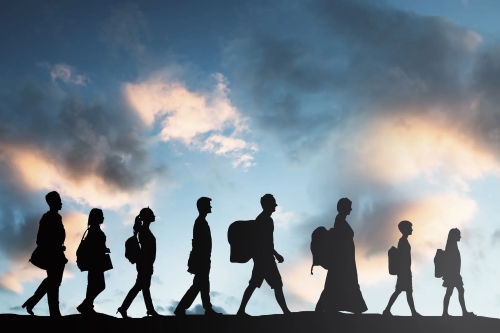Indian nationals are being deported from the United States primarily due to immigration law violations, including unlawful entry and visa overstays. The U.S. Department of Homeland Security (DHS) has intensified enforcement, leading to an increase in repatriations. India and the U.S. are working together to manage irregular migration.
What are the Reasons for the Deportation of Indian Migrants from the US?
- Illegal Entry: Many Indian migrants attempt to cross into the U.S. through Mexico or Canada without proper documentation.
- Visa Overstay: A significant number of Indian nationals exceed their permitted stay duration.
- Stricter Immigration Policies: The U.S. has increased its enforcement of immigration laws, leading to more deportations.
- Criminal Backgrounds: Those involved in fraudulent activities or criminal offenses face deportation.

Source: oecd.org
What are Recent Developments Regarding DeportationsTrends?
Deportation Trends
- October 22, 2024: A charter flight deported around 100 Indian nationals, primarily from Punjab.
- FY 2024: The U.S. deported approximately 1,100 Indian migrants lacking legal status.
- January 2025 Proposal: India has offered to repatriate 18,000 undocumented Indian citizens to strengthen bilateral relations and protect visa programs for skilled workers and students.
U.S.-India Cooperation
- India and the U.S. have initiated discussions to streamline legal migration and address the issue of irregular immigration.
- The Indian government is actively assisting U.S. authorities in identifying and repatriating undocumented nationals.
How India’s Diplomatic Stand on Deportation?
India’s Response to US Deportation Policies
- Indian officials have assured the US of their cooperation in taking back undocumented Indian immigrants.
- This aligns with India’s diplomatic priority to ensure that legal immigration channels remain unaffected.
- The Indian government has sought to ensure that mass deportations do not become a public spectacle, which could create political sensitivities at home.

Key Diplomatic Engagements
- External Affairs Minister S. Jaishankar has held discussions with top US officials, including:
- Secretary of State Marco Rubio
- National Security Advisor Mike Waltz
- Treasury Secretary Scott Bessent
- Commerce Secretary nominee Howard Lutnick
- FBI Director nominee Kash Patel
- Energy Secretary nominee Chris Wright
- India has emphasized that skilled professionals and students must not be affected by stringent immigration policies.
Scale of Deportation and US Immigration Enforcement
Statistics on Deportation
| Category | Number of Deportations |
| Total illegal immigrants deported by US in FY2024 | 271,484 |
| Estimated illegal Indian immigrants in the US | 725,000 |
| Identified Indian immigrants for deportation | 20,000 |
| Indian immigrants deported in 2024 | 1,100 |
What are the Challenges for US Authorities?
Challenges for the US Authorities are:
- Enforcement Targets: ICE field offices are given daily quotas for detaining undocumented immigrants.
- Resource Constraints: ICE has only about 40,000 detention beds and is relying on military resources.
- Guantanamo Bay Detention: Plans are underway to house up to 30,000 detainees at the controversial facility.
How Military is Involved in Deportation?
Use of Military Planes for Deportation
- The US has deployed C-17 military transport aircraft for deportations.
- This method, though effective, is costly; a recent deportation flight to Guatemala reportedly cost $4,675 per migrant.
- India-bound deportations mark the farthest destination covered under this initiative.
- The Pentagon has also facilitated flights for 5,000+ immigrants from detention centers in El Paso, Texas, and San Diego, California.
Countries Receiving US Deportation Flights
List of Countries that will get the mode of transport for deportation:
| Destination | Mode of Transport |
| Guatemala | Military aircraft |
| Peru | Military aircraft |
| Honduras | Military aircraft |
| India | Military aircraft |
What are the Concerns About Legal Immigration & Skilled Professionals?
Indian Students and Skilled Workers in the US
- Total Indian students in the US (as of May 2024): 351,000 (primarily in STEM fields)
- H-1B Visas Issued to Indians (2022-23): 72% of the 400,000 total
- Top Indian IT Companies Benefiting from H-1B:
- Infosys
- TCS
- HCL
- Wipro
India’s Stance on H-1B and Legal Immigration
- Indian officials argue that students and skilled professionals contribute positively to the US economy.
- Trump has expressed support for the H-1B program, stating that the US needs "competent" professionals.
- The concern is that broader immigration restrictions might indirectly impact legal immigrants.
.jpg)
How do both nations stand on the Political and Strategic Implications regarding deportations?
For India:
- Maintaining smooth legal immigration routes is a priority.
- Avoiding high-visibility deportations to prevent domestic backlash.
- Ensuring that skilled migration remains unaffected.
For the US:
- Addressing domestic concerns on illegal immigration.
- Balancing bilateral relations with India while implementing stricter policies.
- Avoiding legal challenges to mass deportation efforts.

Conclusion
The US-India immigration issue is evolving as part of a broader strategy for migration enforcement. While India is open to taking back illegal immigrants, it remains committed to ensuring that legitimate travel and employment opportunities for Indians in the US remain unaffected. The involvement of military planes in deportations signals an aggressive push by the Trump administration but also raises concerns about diplomatic sensitivities and logistical challenges.
Comments
All Comments (0)
Join the conversation